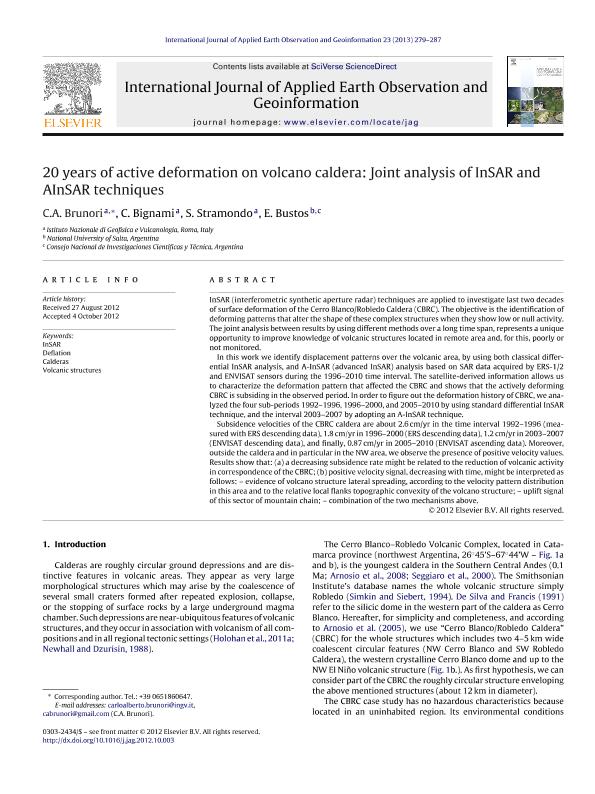Artículo
20 years of active deformation on volcano caldera: Joint analysis of InSAR and AInSAR techniques
Fecha de publicación:
08/2013
Editorial:
Elsevier Science
Revista:
Itc Journal
ISSN:
0303-2434
Idioma:
Inglés
Tipo de recurso:
Artículo publicado
Clasificación temática:
Resumen
InSAR (interferometric synthetic aperture radar) techniques are applied to investigate last two decades of surface deformation of the Cerro Blanco/Robledo Caldera (CBRC). The objective is the identification of deforming patterns that alter the shape of these complex structures when they show low or null activity. The joint analysis between results by using different methods over a long time span, represents a unique opportunity to improve knowledge of volcanic structures located in remote area and, for this, poorly or not monitored. In this work we identify displacement patterns over the volcanic area, by using both classical differential InSAR analysis, and A-InSAR (advanced InSAR) analysis based on SAR data acquired by ERS-1/2 and ENVISAT sensors during the 1996-2010 time interval. The satellite-derived information allows us to characterize the deformation pattern that affected the CBRC and shows that the actively deforming CBRC is subsiding in the observed period. In order to figure out the deformation history of CBRC, we analyzed the four sub-periods 1992-1996, 1996-2000, and 2005-2010 by using standard differential InSAR technique, and the interval 2003-2007 by adopting an A-InSAR technique. Subsidence velocities of the CBRC caldera are about 2.6 cm/yr in the time interval 1992-1996 (measured with ERS descending data), 1.8 cm/yr in 1996-2000 (ERS descending data), 1.2 cm/yr in 2003-2007 (ENVISAT descending data), and finally, 0.87 cm/yr in 2005-2010 (ENVISAT ascending data). Moreover, outside the caldera and in particular in the NW area, we observe the presence of positive velocity values. Results show that: (a) a decreasing subsidence rate might be related to the reduction of volcanic activity in correspondence of the CBRC; (b) positive velocity signal, decreasing with time, might be interpreted as follows: - evidence of volcano structure lateral spreading, according to the velocity pattern distribution in this area and to the relative local flanks topographic convexity of the volcano structure; - uplift signal of this sector of mountain chain; - combination of the two mechanisms above.
Palabras clave:
Insar
,
Deflation
,
Calderas
,
Volcanic Structures
Archivos asociados
Licencia
Identificadores
Colecciones
Articulos(INENCO)
Articulos de INST.DE INVEST.EN ENERGIA NO CONVENCIONAL
Articulos de INST.DE INVEST.EN ENERGIA NO CONVENCIONAL
Citación
Brunori, C. A.; Bignami, C.; Stramondo, S.; Bustos, Emilce; 20 years of active deformation on volcano caldera: Joint analysis of InSAR and AInSAR techniques; Elsevier Science; Itc Journal; 23; 8-2013; 279-287
Compartir
Altmétricas




